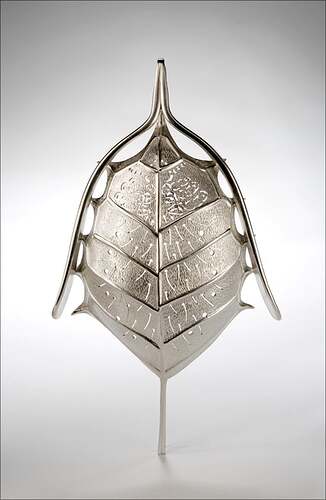“Intimate Symmetry With Dog-Sucking Louse” Tea Strainer
Materials: Sterling silver
Dimensions: 5 1/2 x 1 x 2 7/8"
Tea Strainer: Formed, forged, fabricated.
Photo credit: Tim Thayer
Thomas Muir
Perrysburg, OH. USA
The hollowware vessel is more than an arbitrary vehicle for functional or aesthetic exploration. Historically, and in my own interpretation of it, it is a metaphor for the body and life; its emphasis is on the interior and speaks of containment, shelter, and nourishment. These vessels stem from venerable craft traditions of metalsmithing, woodworking and textiles, establishing a link to long traditions of household use and ornament. The vessel is one of the most basic, ancient, and accessible artistic forms. All of the things that sustain, enrich, and celebrate life can be encapsulated in the vessel: it evokes the womb, the seed, cooking and food storage, human dwellings, and the like. Metaphorically, the vessels address issues of renewal, transformation, and growth, as well as social, psychological, and ecological concerns.
These containers and vessels definitely hold their place in the world of stunning art objects as well as in the world of metalsmithing.
Since the dawn of time humans have created containers to hold things that were important to them, from large vessels to hold food and harvests to intimate containers for small precious things. They might hold memories, ashes, medicine, beverage, fruit or food - but all spring from the imagination and skill of the maker. Some have specific religious functions, some are meant for everyday use. When one thinks of a vessel or container the inclination is to think of something with solid walls - yet many of these works involve the exploration of positive and negative space, and the use of negative space to help create the illusion of the wall of the vessel.
As the world’s largest jewelry related internet site, Ganoksin strives to develop exhibitions showcasing work from around the world. This exhibition was open to all metalsmiths, professional and amateur, advanced and beginner. Participants are from The Netherlands, the USA, Canada, Australia, Costa Rica, the United Kingdom, Israel, Hong Kong, Colombia, Romania, Italy, Ireland, Japan, Malaysia and Denmark. While most of the pieces are by an individual metalsmith, some are collaborations, one of three artists spanning 50 years.
In total 319 artists contributed 729 show pieces for the permanent online exhibition.
Objects in the exhibition include boxes, lockets, urns, ash containers, bowls, wine cups, reliquaries, match holders, vases, teapots, pitchers, sugar bowls, baskets, nests, pillboxes, clutches and a range of sculptural forms. A variety of techniques are showcased covering a wide range of metalsmithing techniques. Materials used include everything from gold and silver to less expensive metals. Ornamentation includes the addition of enamel, chasing and repousse’, gemstones and found objects.
The exhibition was curated by Beth Wicker, President of the North Carolina Society of Goldsmiths in the United States, and Adjunct Instructor at Northeastern Technical College in South Carolina. Director of the exhibition is Hanuman Aspler, founder of The Ganoksin Project, the world’s largest internet jewelry site.
